Zheng Shanjie, chairman of China’s National Development and Reform Commission, announced a series of measures to boost the country’s economy during a press conference. While he did not unveil any major new stimulus plans, he stated that China will expedite special purpose bond issuance to local governments to support regional economic growth. Additionally, ultra-long special sovereign bonds totaling 1 trillion yuan have been used to fund local projects, and more will be issued next year. The central government will also release a 100 billion yuan investment plan for next year earlier than scheduled.
Upon returning from a weeklong holiday, Chinese markets saw a rally lose steam as policymakers refrained from implementing more stimulus measures. The CSI 300 blue chip index, Shanghai Composite Index, and SZSE Component Index all scaled back gains after initially rising. Despite this, Zheng expressed confidence in achieving the full-year economic growth target and announced measures to support the property market and boost domestic spending. While some investors may be disappointed by the lack of specific figures, China’s pro-growth policy stance remains intact.
The Economist Intelligence Unit’s principal economist, Yue Su, maintained her growth forecast for China this year and next, predicting growth of 4.7% and 4.8%, respectively. She suggested that Beijing could provide additional fiscal support ranging from 1 trillion to 3 trillion yuan to boost the real economy. Shaun Rein, from China Market Research Group, indicated that many western investors may opt to take profits and wait for further stimulus from the government before reinvesting. Without substantive fiscal stimulus, the market rally may lose momentum.
Prior to the holiday, Chinese leaders emphasized the need for stronger fiscal and monetary policy support to address the economic challenges posed by a prolonged downturn. The government introduced a series of stimulus measures aimed at revitalizing the property market and stimulating domestic demand. China’s economic growth had slowed, with the GDP growth rate of 4.7% in the April-June quarter marking its slowest since 2023. Furthermore, disappointing economic data, including a contraction in factory activity for the fifth straight month, indicated the need for continued policy adjustments.
Zheng previously stated in March that China would strengthen macroeconomic policies through coordination of fiscal, monetary, employment, industrial, and regional policies. While acknowledging the challenges in meeting growth targets, he emphasized the ongoing efforts to adjust macroeconomic policies to support economic recovery. The economy’s performance, including slower-than-expected consumer price and factory activity growth, underscores the need for sustained policy support to overcome the challenges brought on by the Covid-19 pandemic and domestic economic trends. Future updates on China’s economic policies and stimulus measures are expected.


